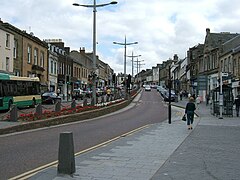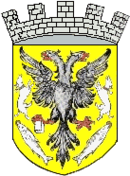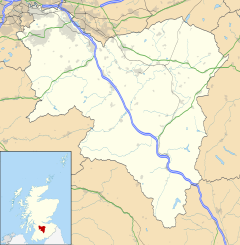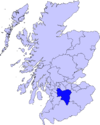Lanark
This article has multiple issues.Please helpimprove itor discuss these issues on thetalk page.(Learn how and when to remove these template messages)
|
Lanark
| |
|---|---|
 Lanark High Street, August 2006 | |
 Coat of Arms of theRoyal Burghof Lanark | |
Location withinSouth Lanarkshire | |
| Population | 8,880 (2022)[1] |
| OS grid reference | NS8843 |
| •Edinburgh | 29+1⁄2miles (47.5 km) |
| •London | 325 miles (523 km) |
| Council area | |
| Lieutenancy area | |
| Country | Scotland |
| Sovereign state | United Kingdom |
| Post town | LANARK |
| Postcode district | ML11 |
| Dialling code | 01555 |
| Police | Scotland |
| Fire | Scottish |
| Ambulance | Scottish |
| UK Parliament | |
| Scottish Parliament | |
Lanark(/ˈlænərk/LAN-ərk;Scottish Gaelic:Lannraig[2][ˈl̪ˠaun̪ˠɾɪkʲ];Scots:Lanrik[3]) is a town inSouth Lanarkshire,Scotland, located 20 kilometres to the south-east ofHamilton.The town lies on theRiver Clyde,at its confluence withMouse Water.In 2016, the town had a population of 9,050.
Lanark has been aroyal burghsince 1140, and was historically thecounty townofLanarkshire,though in modern times this title belongs to Hamilton. Notable landmarks nearby includeNew Lanark,theCorra Linnand the site ofLanark Castle.
Lanark railway stationand bus interchange have frequent services toGlasgow.There is little industry in Lanark and some residents commute to work in Glasgow andEdinburgh.Its shops serve the local agricultural community and surrounding villages. There is a large modern livestock auction market on the outskirts of the town.
History
[edit]The town's name is believed to come from theCumbricLanercmeaning "clear space, glade".[4]
Lanark has served as an important market town since medieval times, and KingDavid Imade it a royal burgh in 1140, giving it certain mercantile privileges relating togovernmentandtaxation.David I realised that greater prosperity could result from encouraging trade. He decided to create a chain of new towns across Scotland. These would be centres of Norman civilisation in a largely Celtic country, and would be established in such a way as to encourage the development of trade within their area. These new towns were to be known as Burghs.Bastideswere established in France for much the same reason.
When a site had been selected for a new town the King's surveyors would lay out an area for the town's market. Each merchant who came to the town was granted a plot of land (usually rent free for the first few years) bordering on the marketplace. These plots were known asfeusor in royal burghs such as Lanark as burgages. Each burgage in a burgh was the same size, though the size varied between burghs. InForresin the north of Scotland each feu was 24 feet 10 inches (7.57 m) wide and 429 feet (131 m) deep. The layout of the burgages in Lanark can still be easily seen between the north side of Lanark High Street (the former market place) and North Vennel, a lane which runs behind the burgages. Amotte and baileycastle was also constructed at the bottom of Castlegate.
Lanark had four town gates, West Port, East port, Wellgate and Castlegate. West Port gate was demolished in the 1770s.[5]
The first aviation meeting to be held in Scotland was held atLanark Racecoursebetween 6 and 13 August 1910. This location was chosen because the land was relatively flat, the racecourse already had facilities for a paying public, there were stables to act as hangars for the aeroplanes and the racecourse was accessible by both road and by rail, especially asThe Caledonian Railway Companywere prepared to construct a new station near the main entrance. The aeroplanes were transported to the meeting by rail, as aviation technology at the time was not advanced enough to safely fly there. The Lanark meeting took place shortly after a similar event inBournemouthat whichCharles Rollsdied. Influenced by this, it was decided that no aircraft would fly closer than 300 yards (270 m) away from the spectators. For the first time, aeroplanes were accurately timed over a straight measured distance, allowing the first world records to be set, covering flights over 1 mile (1.6 km). The meeting was described byThe Aeromagazine as 'the most successful yet held in Britain'.[6]
A permanent military presence was established in the town with the completion ofWinston Barracksin the 1930s.[7]
Governance
[edit]
The citizens of Lanark form part of various different constituencies. In local elections, they are the main component of theClydesdale North wardwhich elects three representatives toSouth Lanarkshire Council.[8]In elections to theScottish Parliament,Lanark elects its representatives as part of theClydesdale constituency,and also contributes to the election of seven additional list members as part of theSouth of Scotland region.The current Clydesdale MSP isAileen Campbellof the SNP, who defeated the Labour incumbentKaren Gillonin the2011 electionafter Gillon had held the seat since 1999. InWestminster elections,Lanark is part of theLanark and Hamilton Eastconstituency. Labour'sJimmy Hoodrepresented the area in Parliament from 1987 until 2015; since then the MP has beenAngela Crawley.Prior toBrexitin 2020, the town was part of theScotland constituencywhich elected six MEPs to theEuropean Parliament.
Landmarks
[edit]
There are 14 historical closes or vennels in the town - alleyways allowing access to the High street. Some are named after an original shop owner, one is named Wallace close as it depicts key moments of William Wallace's life in Lanark[9]
Visitors to the town can visit the nearbyWorld HeritageSite ofNew Lanark,[10]close to theFalls of Clyde,theCorehouseestate and theScottish Wildlife Trust'sCorehouse Nature Reserve.[11]
The Lanark Museum[12]is located in West Port, inside the YMCA building.
A large boating lake,Lanark Loch,adjoins Lanark Golf Club which has a lovely and historic 18 hole course for more experienced golf players and a 9-hole golf course. The former racecourse now offers pony-trekking activities.
The town's Castlebank Park lies near the former site ofLanark Castle,[13]and allows access to theRiver Clydeand theClyde Walkway.
An ornate gas lamp, known as theprovost's lamp stands at the bottom of the High Street. After the burgh council was abolished in 1975,[14]the provost's lamp, which had historically been placed outside the house of the provost as one of their marks of office, was relocated to the pavement just to the east ofLanark Tolboothon a permanent basis.[15]
One of the churches in the town bears the name of The Old Church of St Kentigern (perhaps better known asSt Mungo), who set up many medieval churches in theScottish Lowlands,includingGlasgow,and died c.612 AD. The town's cemetery stands on the site of The Old Church of St Kentigern, and includes manyCovenantergraves.

St. Nicholas Parish Church stands at the bottom of the high street. The church bell is believed to date from 1110, and may be one of the oldest church bells in the world. It was moved from The Old Church of St Kentigern when St. Nicholas Church was built in 1774. It has been recast four times, including 1659 and 1983. There is an 8-foot (2.45 m) statue of William Wallace in the steeple. This was sculpted by Robert Forrest, from an ancient drawing in the possession of the Society of Antiquaries.
Lanimers
[edit]
This historic background forms the basis for theLanark Lanimers,which take place each year for one week in June. Local primary schoolchildren elect a Lanimers queen and court; and a Lord Cornet is chosen from local businessmen. On the Monday night the Perambulation of the Marches takes place, when townspeople turn out to walk around half the town boundary, following the Lord Cornets past and present as they inspect the border-stones. Traditionally, the townspeople carry "birks" (Scots for "sticks of birch" ), which are small branches of birch trees cut from the woods at the Glenburnie estate. This tradition was started in 1948 by Joseph Doolan, whose family owned the land. The other half of the boundary is inspected on the Wednesday night, again led by the Lord Cornet accompanied by many local riders who participate in the Riding of the Marches, locally referred to as the Rideout. On the Thursday morning, schools and other organisations parade before the Lanimer Queen in themed dress, accompanied bypipe bands.The best Lanimer Lorries win prizes, and after the parade the crowning of the Queen takes place on a temporary stand erected in front of St Nicholas' Church, under the statue ofWilliam Wallace.The Queen holds a reception party in the town's Memorial Hall[16]on the Friday night, where children perform songs and dances.
Notable people
[edit]William Wallaceis one of the most notable people in Lanark's history. A key leader in theScottish Wars of Independence,he is known to have first "drawn his sword to free his native land" atLanark in 1297,killing the English sheriff Haselrig.[17][18]An 8-foot statue of Wallace sits on St Nicholas Church at the town cross dating back to 1817 which was sculpted by Carluke-bornRobert Forrest.[19]

Other notable figures from Lanark include:
- William Smellie(1697–1763), obstetrician[20][better source needed]
- Robert McQueen, Lord Braxfield(1722–1799), senior Scottish judge known as the "hanging judge"[21][22]
- Margaret Agnes Bunn(1799–1883), actress[23]
- William Budge(1828–1919), prominent member ofthe Church of Jesus Christ of Latter-day Saints[24]
- Walter Elliot(1888–1958), Scottish Unionist party politician who served in various cabinet roles[25]
- Judith Hart,Labour party politician who was the Minister for Overseas Development and later elevated to the House of Lords[26]
- Colin Cameron(b.1933), lawyer and Malawian politician[27]
- Jimmy McRae(b.1943), five timeBritish Rally Championin 1981, 1982, 1984, 1987 and 1988, father of Colin and Alister McRae[28][29]
- Colin McRae(1968–2007), rally driver who was the British Rally Champion in 1991 and 1992 andWorld Rally Championin 1995, son of Jimmy McRae and brother of Alister McRae[29][30][31]
- Alister McRae(b.1970), British Rally Champion in 1995, son of Jimmy McRae and brother of Colin McRae[29][32]
Gallery
[edit]-
Town centre
-
High Street
-
Wellgate
-
The "Girnin Dug" statue of a dog erected as a reproach to a neighbour suspected of poisoning the pet[33]
See also
[edit]- Lanark (Parliament of Scotland constituency)
- TheLanark Silver Bell,a horseracing trophy
- Lanark Countyin Ontario, Canada
- Lanark, Ontario,a village in Lanark County
- Lanark Grammar School
- Bonnington Pavilion,a nearby historic feature.
- Whuppity Scoorie Day
- Lanark Lanimers
References
[edit]- ^"Mid-2020 Population Estimates for Settlements and Localities in Scotland".National Records of Scotland.31 March 2022.Retrieved31 March2022.
- ^"Ainmean-Àite na h-Alba (AÀA) – Gaelic Place-names of Scotland".gaelicplacenames.org.Archived fromthe originalon 4 March 2016.Retrieved23 March2018.
- ^"Scotslanguage - Names in Scots - Places in Scotland".scotslanguage.Archivedfrom the original on 8 August 2017.Retrieved23 March2018.
- ^Scottish place names, W. F. H. Nicolaisen, p.164, 172, London, 1976
- ^Rhona Wilson.Old Lanark,Stenlake Publishing, 1998.ISBN1840330198
- ^Arthur W.J.G. Ord-Hume.Scotland's Aviation History,Stenlake Publishing, 2014.ISBN9781840336535
- ^Historic Environment Scotland."Hyndford Road at A70, Winston Barracks, Sergeants' Mess (Category B Listed Building) (LB46982)".Retrieved21 March2019.
- ^"Election results - all wards declared".South Lanarkshire Council.4 May 2012. Archived fromthe originalon 4 December 2014.Retrieved9 August2014.
- ^lanarktrust.co.uk
- ^"New Lanark World Heritage Site and Visitor Attraction Lanarkshire near Edinburgh and Glasgow Scotland".newlanark.org.Archivedfrom the original on 23 March 2021.Retrieved23 March2018.
- ^"Falls of Clyde - Scottish Wildlife Trust".scottishwildlifetrust.org.uk.18 January 2010.Archivedfrom the original on 29 January 2017.Retrieved23 March2018.
- ^"Lanark Museum and the Royal Burgh of Lanark Museum Trust".lanarkmuseum.org.Archived fromthe originalon 2 February 2021.Retrieved23 March2018.
- ^Clarke, John; Glasgow Archaeological Society (1952). Miller, Steuart Napier (ed.).The Roman occupation of south-western Scotland: being reports of excavations and surveys carried out under the auspices of the Glasgow Archaeological Society.Glasgow University Publications. Vol. 83. R. MacLehose.
- ^"Local Government (Scotland) Act 1973".Legislation.gov.uk.Archivedfrom the original on 2 May 2022.Retrieved1 January2023.
- ^"The Provost's Lamp".Discover Lanark.Archivedfrom the original on 17 May 2022.Retrieved1 January2023.
- ^"South Lanarkshire Leisure and Culture".Archivedfrom the original on 17 June 2019.Retrieved17 June2019.
- ^"William Wallace".Wars of Independence.BBC History.Archivedfrom the original on 1 October 2011.Retrieved1 October2011.
- ^Wallace, Andy."Wallace in Lanark".The William Wallace Heritage Trust Lanark. Archived fromthe originalon 30 September 2011.Retrieved1 October2011.
- ^"Lanark from kings to convenanters [sic] ".Local History and Heritage.South Lanarkshire Council.Archivedfrom the original on 31 March 2012.Retrieved1 October2011.
- ^"William Smellie | Scottish physician".Encyclopedia Britannica.Archivedfrom the original on 1 March 2021.Retrieved21 March2021.
- ^"Robert Macqueen, Lord Braxfield (1722-1799)".National Records of Scotland.Scottish Government. 31 May 2013.Archivedfrom the original on 26 February 2024.Retrieved24 June2024.
- ^Cassidy, Jane (19 November 2018)."The life and times of Robert McQueen – the real Weir of Hermiston".The National.Herald & Times Group.ISSN2057-231X.Archivedfrom the original on 24 June 2024.Retrieved24 June2024.
- ^"Margaret Agnes Bunn".Gazetteer for Scotland.Archivedfrom the original on 24 June 2024.Retrieved24 June2024.
- ^Jenson, Andrew (1936).Latter-Day Saint Biographical Encyclopedia.Vol. IV. Salt Lake City: Andrew Jenson Memorial Association. pp. 511–512.Retrieved25 June2024– via Birmingham Young University Library Digital Collection.
- ^Holme, Chris (2 March 2024)."Forgotten Scottish hero who saved Westminster Hall from destruction".The Times.Retrieved25 June2024.
- ^Leadbetter, Russell (27 September 2018)."THOSE WERE THE DAYS - 1967: Judith Hart, 'an influential figure in Scottish politics'".The Herald.Herald & Times Group.ISSN0965-9439.Archivedfrom the original on 25 June 2024.Retrieved25 June2024.
- ^"Cameron, Colin, b 1933 (Scottish lawyer and politician)".University of Edinburgh Online Archives.University of Edinburgh.Archivedfrom the original on 25 June 2024.Retrieved25 June2024.
- ^Smith, Kenny (31 May 2019)."Motorsport's Jimmy McRae has mud, sweat and tears".Scottish Field.ISSN0036-9209.Archivedfrom the original on 24 June 2024.Retrieved24 June2024.
- ^abcEvans, David (1 March 2024)."HOW THE MCRAES DOMINATED THE BRITISH CHAMPIONSHIP".DirtFish.Archivedfrom the original on 24 June 2024.Retrieved24 June2024.
- ^"Obituary: Colin McRae".Belfast Telegraph.Independent News & Media. 17 September 2007.ISSN0307-5664.Archivedfrom the original on 24 June 2024.Retrieved24 June2024.
- ^Peacock, Anthony (17 September 2007)."Colin McRae".The Guardian.ISSN1756-3224.Archivedfrom the original on 24 June 2024.Retrieved24 June2024.
- ^"Rallying: McRae's relative success is the spur for elusive British driver's championship".The Independent.Independent Digital News & Media. 21 February 1998.ISSN1741-9743.Archivedfrom the original on 24 June 2024.Retrieved24 June2024.
- ^"Discover Lanark".Archivedfrom the original on 30 July 2017.Retrieved29 July2017.
- Historical Tours in the Clyde Valley.Published by the Clyde Valley Tourist Association and the Lanark & District Archaeological Association. Printed by Robert MacLehose and Company Limited, Renfrew, Scotland. 1982.
- Building the Royal Burghsby John Barrett and David Iredale. Published in The Scots Magazine. Volume 142, Number 1. January 1995. pp. 10–22.
- Upper Clydesdale: A History and Guideby Daniel Martin. Published by the Tuckwell Press, Phantassie, East Linton. 1999.
- Clydesdale District Guide.Published by Clydesdale District Guide. 1995.
- Lanark Heritage Trail.Published by South Lanarkshire Council. 2001.
External links
[edit] Media related toLanarkat Wikimedia Commons
Media related toLanarkat Wikimedia Commons





![The "Girnin Dug" statue of a dog erected as a reproach to a neighbour suspected of poisoning the pet[33]](https://upload.wikimedia.org/wikipedia/commons/thumb/2/21/The_Girnin_Dug%2C_Lanark.jpg/120px-The_Girnin_Dug%2C_Lanark.jpg)
